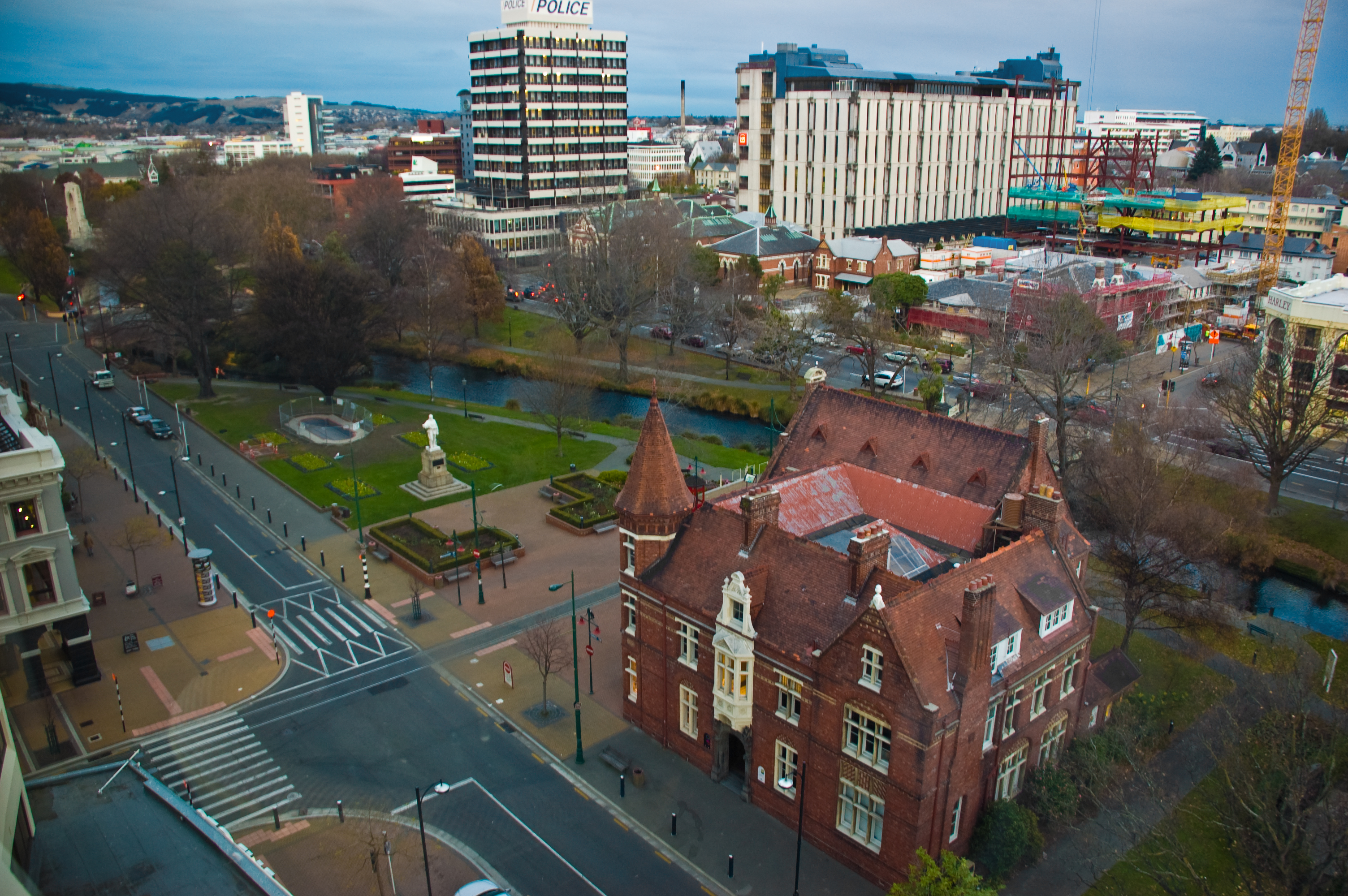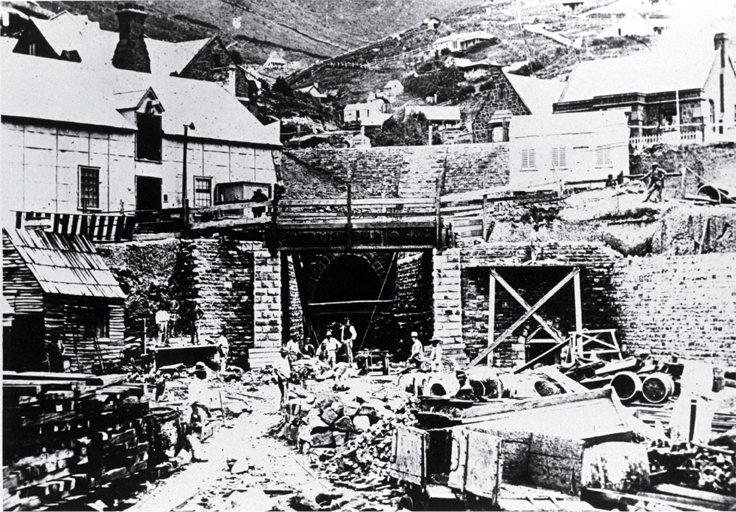|
Henry Thomson (New Zealand Politician)
Henry Thomson JP (1828 – 13 September 1903) was a 19th-century Mayor of Christchurch and Member of Parliament for the electorate in Canterbury, New Zealand. Early life Thomson was born in Dumfriesshire, Scotland, in 1828. He was the fifth son of William Thomson, a shipbuilder. He received his education at Wigtown, Galloway, Scotland. At age 18, he started work for the Liverpool and Manchester Railway. In 1852, he left after six years to emigrate to Victoria, Australia. Thomson was clerk-in-charge of the office of the Melbourne and Hobson's Bay railway during its construction. He was afterwards superintendent of the wharf and railway station at Sandridge (now called Port Melbourne). In 1856, Thomson came to Wellington, and a year later moved to Nelson. On 28 April 1859, he married Mary Ann Thomson (née Coates), daughter of Giles Coates, at Christ Church in Nelson. After two years in Nelson, he had a short experience on the Otago gold fields, and in 1865 settled in Chris ... [...More Info...] [...Related Items...] OR: [Wikipedia] [Google] [Baidu] |
Christchurch North
Christchurch North is a former New Zealand parliamentary New Zealand electorates, electorate. The electorate comprised the northern half of what is now considered the Christchurch Central City. Population centres The previous electoral redistribution was undertaken in 1875 for the 1875–1876 New Zealand general election, 1875–1876 election. In the six years since, New Zealand's European population had increased by 65%. In the 1881 electoral redistribution, the New Zealand House of Representatives, House of Representatives increased the number of European representatives to 91 (up from 84 since the 1875–76 election). The number of Māori electorates was held at four. The House further decided that electorates should not have more than one representative, which led to 35 new electorates being formed, including Christchurch North, and two electorates that had previously been abolished to be recreated. This necessitated a major disruption to existing boundaries. The boundaries o ... [...More Info...] [...Related Items...] OR: [Wikipedia] [Google] [Baidu] |
Melbourne And Hobson's Bay Railway Company
The Melbourne and Hobson's Bay Railway Company was a railway company in Victoria, Australia. The company was incorporated on 20 January 1853 to build the line from Melbourne to the port of Sandridge, now Port Melbourne. The proposal met considerable opposition, despite the inadequacy and high costs of using horse drays and bullock wagons to carry merchandise from the port to the city. However, the combination of chaotic transport conditions and the extravagant financial prosperity that followed the gold rush led the community to realise the urgent need for railway communication on various routes, of which this one was prominent. The colony's pastoral somnolence was interrupted, never to recur, and a "railway boom" set in. The line was constructed to " broad gauge" in keeping with an agreement between the three then extant colonies to adopt that gauge – subsequently abandoned by the government of New South Wales. The first engineer for the line was William Snell Chaunc ... [...More Info...] [...Related Items...] OR: [Wikipedia] [Google] [Baidu] |
Linwood Cemetery Thomson089
Linwood may refer to: Places Many of the place names for Linwood come from the presence of linden trees. Australia *Linwood, South Australia *Linnwood, Guildford Linnwood is a heritage-listed former residence, school, local history museum and children's home and now historical society located at 11-35 Byron Road, Guildford in the Cumberland Council local government area of New South Wales, Australia. It ..., 11-35 Byron Road, Guildford, New South Wales Canada *Linwood, Ontario *Linwood, Nova Scotia New Zealand *Linwood, New Zealand **Linwood (New Zealand electorate) **Linwood Cemetery, Christchurch **Linwood College **Linwood North School United Kingdom *Linwood, Hampshire, England *Mary Linwood Comprehensive School, Leicester, England *Linwood, Lincolnshire, England *Linwood, Renfrewshire, Scotland **Linwood High School United States *Linwood Elementary School (Georgia), Warner Robins, Georgia *Linwood, Indiana *Linwood Cemetery (Dubuque), Iowa *Linwood, Kansas *Linwood ... [...More Info...] [...Related Items...] OR: [Wikipedia] [Google] [Baidu] |
Christchurch City Council
The Christchurch City Council is the local government authority for Christchurch in New Zealand. It is a territorial authority elected to represent the people of Christchurch. Since October 2022, the Mayor of Christchurch is Phil Mauger, who succeeded after the retirement of Lianne Dalziel. The council currently consists of 16 councillors elected from sixteen wards, and is presided over by the mayor, who is elected at large. The number of elected members and ward boundaries changed prior during the 2016 election. History As a result of the 1989 local government reforms, on 1 November 1989 Christchurch City Council took over the functions of the former Christchurch City Council, Heathcote County Council, Riccarton Borough Council, Waimairi District Council, part of Paparua County Council, and the Christchurch Drainage Board. On 6 March 2006, Banks Peninsula District Council merged with Christchurch City Council. Councillor Yani Johanson campaigned since 2010 to live-strea ... [...More Info...] [...Related Items...] OR: [Wikipedia] [Google] [Baidu] |
Christchurch North (New Zealand Electorate)
Christchurch North is a former New Zealand parliamentary electorate. The electorate comprised the northern half of what is now considered the Christchurch Central City. Population centres The previous electoral redistribution was undertaken in 1875 for the 1875–1876 election. In the six years since, New Zealand's European population had increased by 65%. In the 1881 electoral redistribution, the House of Representatives increased the number of European representatives to 91 (up from 84 since the 1875–76 election). The number of Māori electorates was held at four. The House further decided that electorates should not have more than one representative, which led to 35 new electorates being formed, including Christchurch North, and two electorates that had previously been abolished to be recreated. This necessitated a major disruption to existing boundaries. The boundaries of the Christchurch North electorate were Bealey Avenue in the north (then called North Town Belt), Fitzg ... [...More Info...] [...Related Items...] OR: [Wikipedia] [Google] [Baidu] |
Main South Line
The Main South Line, sometimes referred to as part of the South Island Main Trunk Railway, is a railway line that runs north and south from Lyttelton in New Zealand through Christchurch and along the east coast of the South Island to Invercargill via Dunedin. It is one of the most important railway lines in New Zealand and was one of the first to be built, with construction commencing in the 1860s. At Christchurch, it connects with the Main North Line to Picton, the other part of the South Island Main Trunk. Construction Construction of the Main South Line falls into two main sections: from Christchurch through southern Canterbury to Otago's major city of Dunedin; and linking the southern centres of Dunedin and Invercargill, improving communication in southern Otago and large parts of Southland. Construction of the first section of the line began in 1865 and the whole line was completed on 22 January 1879. Christchurch-Dunedin section The Canterbury provincial government ... [...More Info...] [...Related Items...] OR: [Wikipedia] [Google] [Baidu] |
Selwyn District
Selwyn District is a predominantly rural district in central Canterbury, on the east coast of New Zealand's South Island. It is named after the Selwyn River / Waikirikiri, which is in turn named after Bishop George Selwyn, the first Anglican bishop of New Zealand who, in 1843 and 1844, travelled the length of the country by horse, foot, boat and canoe, leaving in his wake a sprinkling of locations that now bear his name. History The first inhabitants of the area were the Māori who first settled New Zealand from the Cook and Society Islands about 700 years ago. The predominant Māori tribe today, in Selwyn and most of the rest of the South Island, is Ngāi Tahu, whose local marae (meeting house) is at Taumutu near the exit of Lake Ellesmere (Te Waihora). In the late 19th century, European (chiefly British) colonists arrived and carved the area up into farmland. This has remained the predominant pattern ever since. The Selwyn District as a unit of government was formed in the ... [...More Info...] [...Related Items...] OR: [Wikipedia] [Google] [Baidu] |
Canterbury Provincial Railways
The Canterbury Provincial Railways was an early part of the Rail transport in New Zealand, railways of New Zealand. Built by the Canterbury Province, Canterbury Provincial government mainly to the broad gauge of , the railway reached most of the Canterbury region by the time the province was abolished in 1876. Edward Dobson, the Provincial Engineer from 1854 to 1868, was the designer and overseer. History New Zealand's first public railway was opened from Christchurch to Ferrymead Railway, Ferrymead in 1863. In 1867 the Ferrymead section was made redundant when the Lyttelton Line, line through the Lyttelton rail tunnel to the port of Lyttelton, New Zealand, Lyttelton opened. The contractors who had built the line, Holmes and Company of Melbourne, operated the trains until 31 July 1868, when the Canterbury Provincial Railways took direct control. The contractors selected the broad gauge used for the railway, as it was the same gauge in use for Rail transport in Victoria, railways i ... [...More Info...] [...Related Items...] OR: [Wikipedia] [Google] [Baidu] |
Central Otago Gold Rush
The Otago Gold Rush (often called the Central Otago Gold Rush) was a gold rush that occurred during the 1860s in Central Otago, New Zealand. This was the country's biggest gold strike, and led to a rapid influx of foreign miners to the area – many of them veterans of other hunts for the precious metal in California Gold Rush, California and Victorian Gold Rush, Victoria, Australia. The rush started at Gabriel's Gully but spread throughout much of Central Otago, leading to the rapid expansion and commercialisation of the new colonial settlement of Dunedin, which quickly grew to be New Zealand's largest city. Only a few years later, most of the smaller new settlements were deserted, and gold extraction became more long-term, industrialised-mechanical process. Background Previous gold finds in New Zealand Previously gold had been found in small quantities in the Coromandel Peninsula (by visiting whalers) and near Nelson, New Zealand, Nelson in 1842. Commercial interests in Auc ... [...More Info...] [...Related Items...] OR: [Wikipedia] [Google] [Baidu] |
Christ Church Cathedral, Nelson
Christ Church Cathedral is an Anglican cathedral in upper Trafalgar Street, Nelson, New Zealand with seating for 350 people. It is 58 metres in length and 27 metres wide. The tower is 35 metres high. History The original church was erected in 1851 at a different site, and enlarged in 1859. In 1866 the church was named as Christ Church Cathedral and enlarged again. In 1887 a second church was constructed at the current site using much of the same materials of the previous cathedral. In 1925 the current church construction began. Construction was finished in 1965. The majority of marble was sourced from the Pakikiruna Range, near Tākaka. When construction started the marble was to be used in blocks. However, after the 1929 Murchison earthquake this was deemed too risky and far too expensive. The marble was then ground down and mixed with plaster to give the unusual appearance and colour. The steps are constructed from granite. This granite was obtained from Tonga Beach, whic ... [...More Info...] [...Related Items...] OR: [Wikipedia] [Google] [Baidu] |
Nelson, New Zealand
(Let him, who has earned it, bear the palm) , image_map = Nelson CC.PNG , mapsize = 200px , map_caption = , coordinates = , coor_pinpoint = , coordinates_footnotes = , subdivision_type = Country , subdivision_name = New Zealand , subdivision_type1 = Unitary authority , subdivision_name1 = Nelson City , subdivision_type2 = , subdivision_name2 = , established_title1 = Settled by Europeans , established_date1 = 1841 , founder = Arthur Wakefield , named_for = Horatio Nelson , parts_type = Suburbs , p1 = Nelson Central , p2 = Annesbrook , p3 = Atawhai , p4 = Beachville , p5 = Bishopdale , p6 = Britannia Heights , p7 = Enner Gly ... [...More Info...] [...Related Items...] OR: [Wikipedia] [Google] [Baidu] |






